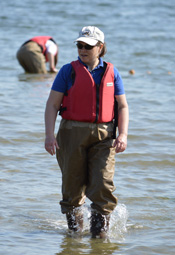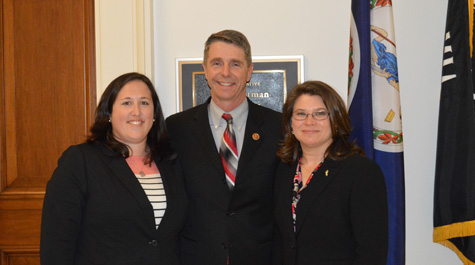Local teacher named 2014 Regional Educator of the Year
Gwartney-Green actively involved in VIMS’ education programs
The Chesapeake Bay Trust recently recognized Judy Gwartney-Green, a 7th-grade life science teacher at Peasley Middle School in Gloucester, for her contributions to environmental education and Chesapeake Bay restoration.
Gwartney-Green has long been involved in educational programs at the Virginia Institute of Marine Science, partnering with educators in both the Marine Advisory Services program and the Chesapeake Bay National Estuarine Research Reserve program at VIMS.
The Chesapeake Bay Trust is a Maryland-based non-profit dedicated to improving Chesapeake Bay through education, outreach, and restoration. Its annual awards program recognizes awardees for a variety of environmental leadership roles and achievements. Gwartney-Green was awarded with the 2014 Regional Educator of the Year award and received a $2,500 grant for her school to use for environmental-education programs.
One of four life science teachers at Peasley, Gwartney-Green says she was completely floored when she discovered her colleague Stephanie Sowers had nominated her for the award. “I was shocked that she selected me for this, and that so many people I hold in high regard wrote letters of recommendation,” she says. “The four of us attended the ceremony at the Maryland General Assembly together, and it was so nice to have them with me to accept the award.”
Last week, Gwartney-Green traveled to Washington, D.C. for a session highlighting the National Estuarine Research Reserve program during “Coast Day” on Capitol Hill. Gwartney-Green served as a Virginia representative for “local schoolteachers,” providing a case study of how her partnership with Dr. William Reay and Sarah Nuss of the Chesapeake Bay National Estuarine Research Reserve (CBNERR) at VIMS has helped her and her students to become better stewards of Chesapeake Bay. She joined a state reserve manager, a university research scientist, and a non-profit president in presenting case studies from California, Maine, and Massachusetts.
Nuss says she immediately thought of Gwartney-Green when session organizers asked her to recommend a teacher who would be willing to share their story about how CBNERR works to educate the next generation. “I’ve worked with Judy for many years and have always admired her dedication to her students and environmental education,” says Nuss. “Her recent receipt of the Chesapeake Bay Trust’s award was also a great accomplishment to showcase at the Capitol Hill briefing.”
Gwartney-Green has been a life science teacher at Peasley since her former school—Page—was destroyed by the tornado that swept through Gloucester County in 2011. Peasley and Page have been actively involved with VIMS programs since 2005, both through grants to CBNERR from NOAA’s Bay Watershed Education Training (BWET) program and through participation in the NSF-funded PERFECT/GK-12 program.
“The kids that I teach are going to make decisions about our environment that will affect their lives, their children’s lives, and my life,” says Gwartney-Green. “It’s important that they have the information-base to make informed decisions about what’s best for the environment.”
Gwartney-Green got involved with CBNERR’s BWET program when she started teaching at Page in 2006. The program—which is designed to ensure that every student receives a meaningful watershed educational experience before graduating from high school—has evolved through the years, and now mostly focuses on training teachers in new ways to educate their students about marine life.
“VIMS has shaped the way I teach in more ways than I can count,” says Gwartney-Green. “I’ve learned so much about Bay ecology and organisms, and now the Bay is in my curriculum no matter what we’re doing. When we talk about interactions between organisms, we are talking about Bay organisms.”
In addition to her participation in the BWET program, Gwartney-Green each year welcomes fellows from VIMS’ PERFECT/GK12 program into her classroom. The fellowship—which started in 2009—supports training for graduate students in science, technology, engineering, and mathematics (STEM) through interactions with teachers and students in K-12 schools.
“The GK-12 program is so wonderful because it affects all three of us—the students, the fellows, and me as a teacher,” says Gwartney-Green. “The kids get to see real science from real scientists, which shows them that scientists are not just the wild-haired mad scientists they see on television. The fellows get the opportunity to bring their research into a classroom and explain it in a totally different way, and their fresh perspective helps me to change things up.”
“Judy has been a wonderful teacher for our GK-12 fellows, and simultaneously inspires science communication and life-long learning in her classroom,” says GK-12 co-manager Carol Hopper Brill. “Each summer, Judy dives into her fellow’s research, and helps them translate their authentic science into lessons that can engage and inspire 7th graders, and she takes advantage of having GK-12 Fellows in her classroom so she can show her students that she is learning too.”
“It has been such a pleasure working with Judy and her students these past few years,” says Nuss. “She’s an amazing educator and well deserving of the Regional Educator of the Year Award.”
Gwartney-Green says that she and her fellow science teachers haven’t decided exactly how they will allocate the funds received from the award, but that field trips and planting a garden would be a great way to put the money to good use.




